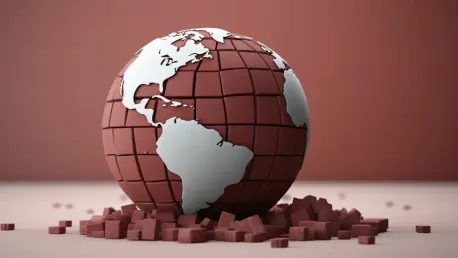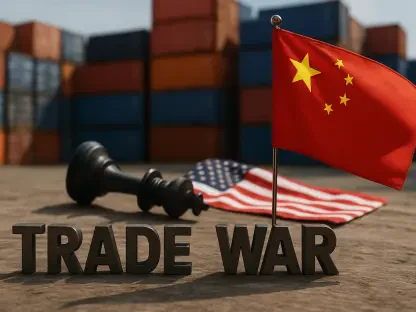In April 2025, President Trump implemented significant tariff increases on U.S. imports, marking the most dramatic shift in U.S. trade policy in over a century. Economic experts foresee these tariffs leading to higher inflation and slower growth, raising fears of a global recession. The scope of these changes has created widespread concern among economists, policymakers, and business leaders.
Introduction to Trump’s Tariff Measures
Historical Context and Immediate Concerns
President Trump’s new tariffs have raised the average effective U.S. tariff rates to between 22.5% and 24%, the highest since 1910. The scope and magnitude of this policy change underscore its historic nature, compared to over a century of trade practices that mainly fostered lower tariffs and open trade. Jerome Powell, U.S. Federal Reserve Chair, has cautioned that these high tariffs could lead to severe economic repercussions, triggering increased inflation and slower economic growth. Powell’s remarks reflect a broader concern within the financial community that these measures could disrupt economic stability both domestically and internationally.
Expert Predictions on Recession Risks
Leading economists, including George Pearkes from Bespoke Investment Group and Justin Wolfers from the University of Michigan, have highlighted the heightened likelihood of a recession driven by these elevated tariffs. According to their analyses, the risk of an economic downturn has substantially increased. JPMorgan has projected a staggering 60% risk of a global recession, based on current trends and anticipated retaliatory measures by trading partners. The rapid escalation in recession risk highlights the tenuous balance within global markets, raising alarms for both investors and government entities worldwide.
Key Themes and Economic Impact
Direct Consumer Impact
Wolfers has pointed out that these tariffs will directly impact consumers, significantly raising prices and fundamentally altering their financial situations. It is projected that the tariffs will lead to a 2.3% increase in consumer prices within this year, resulting in an average financial loss of approximately $3,800 per U.S. household. The repercussions of these elevated costs will be felt most acutely by lower-income households, already struggling with rising living costs. Moreover, the tariffs’ impact extends beyond imported goods alone. For instance, higher costs for auto parts are expected to drive up insurance premiums, further exacerbating financial strains on everyday Americans.
Business Investment and Manufacturing Costs
With half of U.S. imports consisting of production inputs, businesses are bracing themselves for a substantial increase in manufacturing costs due to the tariffs. These increased costs come at a time when American enterprises are still recovering from previous economic disruptions. Analysts predict that the rising costs will reduce real GDP growth by about 0.9% in the current year, coupled with an anticipated 18.1% decline in exports. These figures underscore the broad economic impact of higher tariffs, affecting a wide range of industries from manufacturing to agriculture. The expected decrease in exports adds another layer of concern, as businesses face shrinking international markets and increased domestic production costs.
Global Retaliation and Federal Reserve Challenges
Retaliatory Tariffs and Trade Reductions
In response to the U.S. tariff increases, trading partners are likely to impose their own retaliatory tariffs. This reciprocity will not only strain bilateral economic relationships but will also have wider ramifications for global trade volumes. Experts predict a reduction of approximately 1% in global trade volumes, which can significantly impact economies that rely heavily on exports and imports. This chain reaction from trading partners seeking to protect their own economies could lead to prolonged trade disputes and geopolitical tensions, further destabilizing global markets.
Stagflation and Federal Reserve Response
The increased tariffs have the potential to create a unique economic challenge known as stagflation, characterized by rising inflation coupled with slow economic growth. This situation poses a particularly difficult challenge for the Federal Reserve, whose conventional tool of adjusting interest rates may not effectively address the dual issues of inflation and stagnation. With a limited ability to control both increased prices and foster economic growth simultaneously, the Federal Reserve faces a complex dilemma. Effective policy responses will be critical in mitigating the adverse effects of stagflation, underscoring the importance of adaptive and nuanced economic strategies.
Overarching Trends and Expert Consensus
Tariffs’ Broad Economic Impact
Analysts across the board agree that significant tariffs on production inputs will have harmful effects on the U.S. and global economies. The heightened likelihood of a U.S. recession has led to widespread concern, with many predicting an economic downturn by the end of the year. The immediate economic concerns surrounding these tariffs include increased consumer costs and higher manufacturing expenses. Supply chains are also anticipated to face disruptions, complicating operational logistics for numerous industries. Furthermore, global retaliatory actions will likely exacerbate these financial strains, collectively painting a bleak outlook for the economy.
American and Global Perspective
Experts such as Harvard economist Greg Mankiw have long argued that protectionist policies like these typically hinder, rather than promote, economic progress. The initial wave of market turmoil and business layoffs underscores Greg Mankiw’s point, highlighting the broader economic repercussions that may follow. The core of the debate lies in the effectiveness of open trade versus protectionist measures, with substantial evidence suggesting that free trade is more beneficial to economic growth and improved living standards. As businesses brace for the anticipated challenges, the key concern remains the severity and spread of the economic downturn precipitated by these aggressive tariffs.
Conclusion
In April 2025, President Trump enacted a significant hike in tariffs on U.S. imports, representing the most substantial shift in American trade policy in over a century. This move has raised widespread concern among economists, policymakers, and business leaders. They warn that these higher tariffs will likely lead to increased inflation and slower economic growth, potentially triggering a global recession. The overarching worry is that escalating trade tensions could disrupt international supply chains, leading to higher costs for consumers and businesses alike. This massive policy change has sparked intense debate among key stakeholders, with some arguing that it may protect domestic industries, while others believe it could harm the global economy. Critics suggest that instead of bolstering U.S. economic interests, such measures may eventually backfire, leading to retaliation from other countries through their own tariffs. The long-term impact remains uncertain, but the risk of significant economic turmoil persists.









